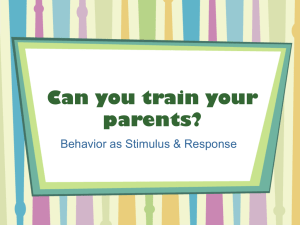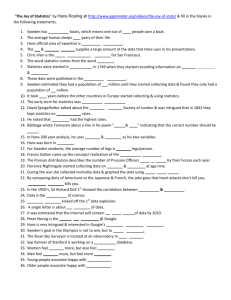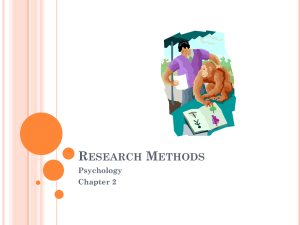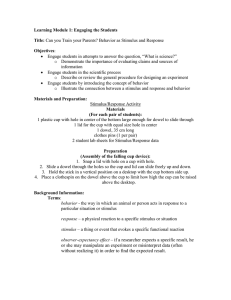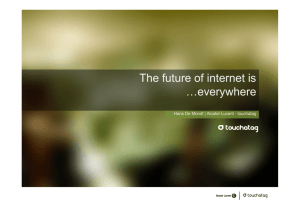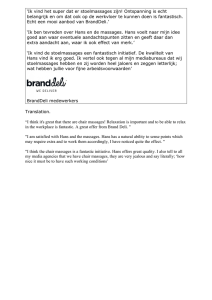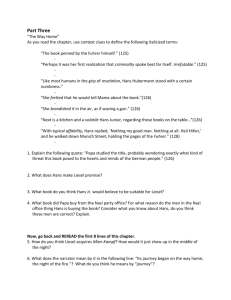Maggie Renken Lesson 1 Handout
advertisement
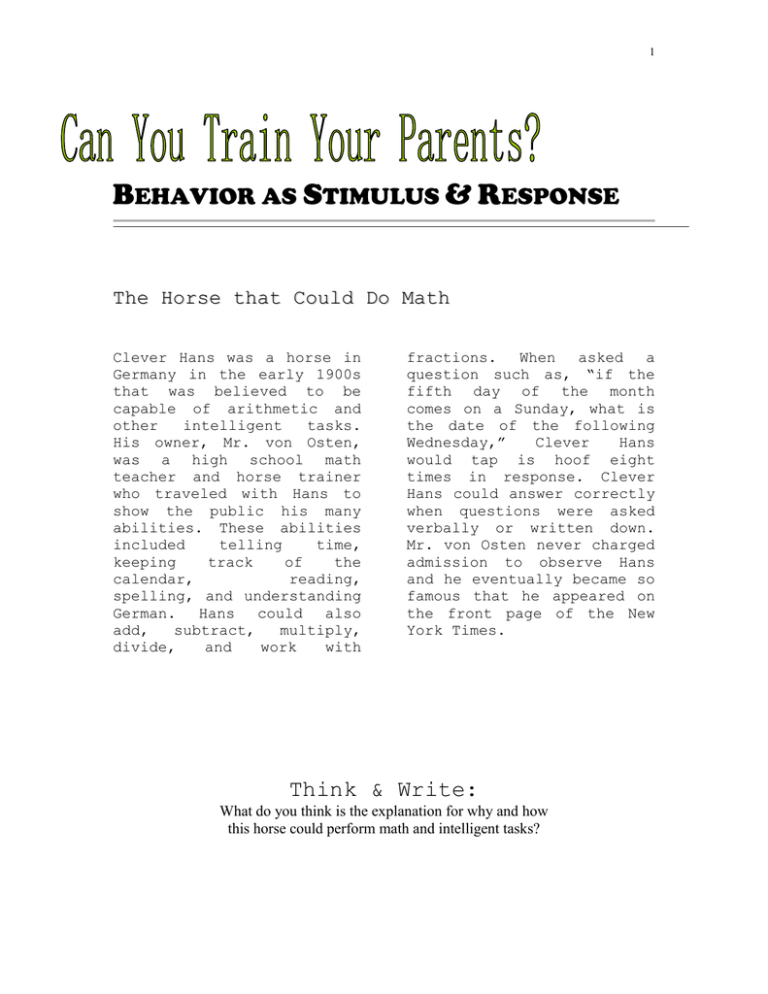
1 BEHAVIOR AS STIMULUS & RESPONSE The Horse t hat Could Do M ath Clever Hans was a horse in Germany in the early 1900s that was believed to be capable of arithmetic and other intelligent tasks. His owner, Mr. von Osten, was a high school math teacher and horse trainer who traveled with Hans to show the public his many abilities. These abilities included telling time, keeping track of the calendar, reading, spelling, and understanding German. Hans could also add, subtract, multiply, divide, and work with fractions. When asked a question such as, “if the fifth day of the month comes on a Sunday, what is the date of the following Wednesday,” Clever Hans would tap is hoof eight times in response. Clever Hans could answer correctly when questions were asked verbally or written down. Mr. von Osten never charged admission to observe Hans and he eventually became so famous that he appeared on the front page of the New York Times. Think & Write: What do you think is the explanation for why and how this horse could perform math and intelligent tasks? 2 the horse had the ability to perform intelligent tasks as well as a human could. What experimenters’ found: What the owner & the audience thought: Clever Hans became famous during a time with Charles Darwin’s theory of evolution was gaining attention. Darwin’s theory suggested that certain intelligent and higher order tasks were confined to humans and higher life forms. In response, Mr. von Osten and others began to test this claim and were certain that Clever Hans was a prime counterexample of this idea. Clever Hans’ owner and audience believed that The Hans Commission Because Hans was becoming so popular, the German Board of Education hired a commission to investigate Mr. von Osten’s claims. The goal was to determine if the claims were scientific or if they were the result of trickery. The commission was made up of 13 scientists, led by Carl Stumpf, a philosopher and psychologist. In 1904, the commission determined that there was no trickery involved in Hans’ performance. Oskar Pfungst The commission turned the investigation over to psychologist Oskar Pfungst, and in 1907, after formal investigation, he proved that rather than performing the tasks, Clever Hans was responding to the reactions of his owner and the audience. Pfungst tested Hans’ abilities by first isolating the horse and the questioner from an audience. This ensured that no cues were coming from the observers. Then, Pfungst used questioners other than Mr. von Osten. Pfungst also put blinders on Hans to vary whether he could see the person asking the questions or not. Finally, Pfungst varied 3 whether the questioner knew the answer to the question. Hans answered correctly regardless of who the questioner was. However, the questioner had to know the correct answer and be visible for Hans to answer correctly. Following these findings, Pfungst studied the questioner’s behavior, and found that the questioner became tense (as evidenced by his posture and facial expression) as Hans’ taps approached the right answer. In addition, the questioner’s tension was released when Hans tapped the final, or correct, tap. Pfungst concluded that Hans was using a cue to know when to stop tapping. This effect, known as the Clever Hans effect, occurred even when the questioner had no idea he was provided such cues. Pfungst further demonstrated that this capacity to detect cues is not confined to horses, and that similar effects are just as likely in experiments with humans and other animals. Understanding this, scientists must be careful to avoid observerexpectancy effect and to make experiments double-blind. 4 Understanding Stimulus and Response As we saw with Clever Hans, behavior can be determined by external cues. A more broad and common definition of behavior is a response to a stimulus. In order for a response to occur, a stimulus must be sensed, processed, and interpreted. First, living organisms rely on their senses to detect a signal. As humans, we use our sense of sight, hearing, smell, touch, and taste among others. Once a signal is detected, it is interpreted, and the organism responds or ignores the signal. Signals may be processed before the brain. This happens when you touch a hot stove. Signals may also be processed in the brain. Dogs do this when they begin salivating for a treat, after smelling the treat and realizing that it will taste good. Signals may also warrant complex interpretation. When you listen to a song, for example, your brain interprets the meanings of words rather than simply sensing and processing the sound. This may lead to an emotional response or a behavior. Responses come in a variety of forms as well. They can be positive, negative, or simply ignore a stimulus. A positive response would include a plant growing toward the sun. A negative response would be a plant’s roots growing around a piece of copper in the ground. An example of responding to a stimulus by ignoring it would be a dog ignoring sounds coming from a television. Stimulus/Response Activity For this stimulus/response activity, record your data by filling in the stimulus (vision) and the response (right hand for the first data box) for each test. One person is the cup releaser and the other is the responder. Each time the responder's hand is hit, an X is recorded in the hit column. Misses are recorded in the miss column. Conduct the investigation three times for your dominant hand, nondominant hand, foot, and with your eyes closed. Remember that the stimulus and response may change for each test. 5 STIMULUS: ________________________ RESPONSE: ________________________ Try Hit Miss 1 2 3 STIMULUS: ________________________ RESPONSE: ________________________ Try Hit Miss 1 2 3 STIMULUS: ________________________ RESPONSE: ________________________ Try Hit Miss 1 2 3 STIMULUS: ________________________ RESPONSE: ________________________ Try Hit Miss 6 1 2 3 Think & Write: How could you test the stimulus and response principles of behavior with your pet or with a friend’s pet? Do you expect an animal’s response times to vary in a pattern similar to your response time? (For instance, would covering an animal’s eyes have the same effect?) Reflection Based on what you have learned about Clever Hans and stimulus and response, design an experiment to test whether or not you can train your parents to do something (safe) that they don’t usually do. 7
